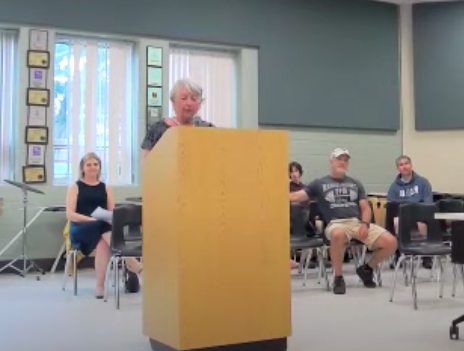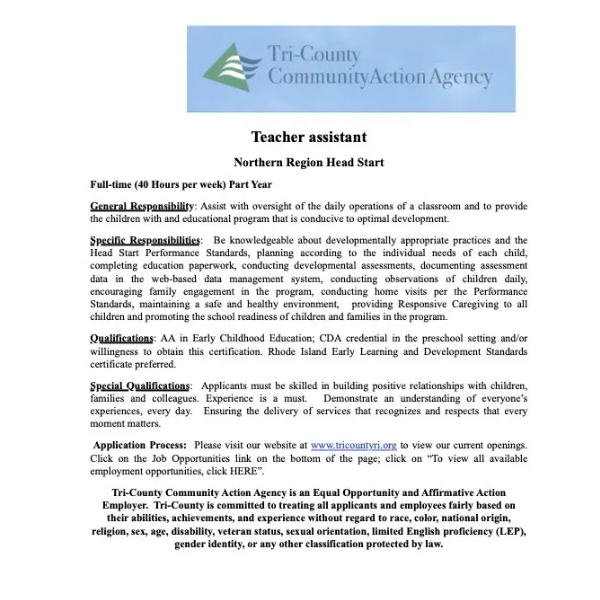NORTH SMITHFIELD – The School Committee moved forward this week on an initiative to expand parking by the North Smithfield High School athletic fields – and potentially add a solar canopy to the lot – but the potential capital project won’t necessarily match a plan pitched last year by solar company Green Development.
Supt. Michael St. Jean said a request for proposals approved last week has three components for contractors: repaving and fixing the parking lot; installing a 60-space expansion; and adding in a solar canopy.
“It doesn’t have to be all of them,” St. Jean said. “What we’ll have is some contractors that will come through. They will take a look at the site. It’s really up to the town to figure out which direction to go.”
The decision this week comes in response to a proposal first presented by officials from Green last year, which would have seen the lot improved free of charge. In turn, the solar business was asking the town to waive all taxes and lease payments for an accompanying energy-harnessing canopy they hoped to install above a portion of the parking lot.
The proposal brought out testimony both from parents who hoped to see safety improvements by the fields, and others opposed to the initiative for reasons including protection of water resources.
“I took a path which I don’t think will make anybody happy because there are very strong opinions on every aspect of this project,” St. Jean said.
“Solar canopies, per our own zoning map and ordinances, are not allowed at the schools, whether they be ground or rooftop mounted,” said resident Mary Cimini last week. “The area surrounding NSHS has long been used to farm by the Goodwin Family and is located near Todds Pond, Primrose Pond and the Audubon Fort Wildlife Refuge.”
“Our most precious commodity, water, is under attack in North Smithfield,” Cimini told the committee.
Cimini’s comments came within days of news that recent tests by the Rhode Island Department of Health showed the school’s drinking water contains per- and polyfluoroalkyl substances – or PFAS – beyond the new statewide standard. A law passed last year mandates that public water systems test for the chemicals, found in many different household products, and known to cause cancers and other health issues.
According to the new law, systems that test above 20 parts per trillion must notify their customers and enter an agreement with RIDOH to remediate the impacted well, and the water system serving the high school and middle school tested at 21 ppt.
In a notice sent out to parents and staff, on Friday, July 21, St. Jean explained.
“For very high levels of PFAS, RIDOH requires that people not drink the water,” he notes. “The level of PFAS in our drinking water is not high enough for RIDOH to require that people not drink it but we must, and will, remediate it.”
“We are taking this matter very seriously and are working closely with RIDOH to finalize and get approval for a plan to fix the PFAS levels as soon as possible,” St. Jean wrote. “We will share updates with you throughout this process.”
At the meeting on Tuesday, July 18, committee members assured Cimini that the town would follow a process for the parking lot project, meanwhile, that will include all zoning and state permitting standards.
“Everything would have to go through zoning,” St. Jean said. “They’d have to have all the proper permits and all of that.”
Committee member William Connell noted that the Zoning Board has rejected plans put forth by the school department in the past.
“It didn’t go forward,” he said, adding of the latest project, “It doesn’t circumvent any of the processes that we’d have to follow.”
St. Jean noted that the project could be eligible for reimbursement from the Rhode Island Department of Education through the state revolving fund.
But ultimately, as a large capital project, the authority on how to move forward will rest with the Town Council, he said.
“We would be passing it on to the town,” said St. Jean. “I can make recommendations, but ultimately, it’s the School Committee, the Town Council and the community that decide what is the best use of our funds.”
And he noted that the lot improvements don’t necessarily require a solar component.
“This RFP isn’t designed to force one thing over another – it’s to give options,” he said. Still, St. Jean added, “I like the thought of solar.”









There is so much more to this story that was not reported in the article. I would recommend that those that have not viewed it do so….these areas and the ponds that surround them lead to watersheds, including the Woonasquatucket River. Interesting that none of those who have been pushing for the canopies have been asked for a comment. But, you know who they are…..Lorraine Joubert an expert from URI has also noted that our elected officials have not done enough to protect the community as noted at the local Water Supply Review Committee. That is why in essence the community should be outspoken regarding the change back to the original zoning districts. In addition, you may also be able to note the correlation between artificial turf fields and PFAS if you research the topic.
The new turf at VMS does not contain harmful levels of PFAS, and passed government testing. How do I know that? I requested information and received documented facts, instead of making s$!# up as I go along.
Tony, if you requested the information from the company selling the field, they lied. Just like the company lied the first time they sold the town the field. If you remember the field would last 20 years and need no maintenance. And if you did some non bias research you would find many experts that say Synthetic turf contains unsafe levels of lead, mercury, cadmium and other known carcinogens. And despite claims to the contrary, synthetic turf is not environmentally friendly.
But Tony adding parking spaces is still a waste of taxpayer money for a few games when NS roads are in awful shape.
The article here says the average is 21ppt, while I’ve seen three other articles say the average is much higher at 31ppt. Is this a mistake as the two and three are close to eachother, or did those other articles post the higher amount only? I don’t want the wrong info being posted. Im looking out for everyone reading so they can have best information to read and make their decisions.
Hi BM. There are two wells and one tested at 2ppt while the other tested 31ppt. The state uses the average – which is 21 – putting the combined wells 1ppt over the 20 ppt limit. I have not seen any news articles that say they average was higher, although I have seen sources that published the numbers from both wells rather than the number that is most significant for testing & remediation purposes – which we used.
They must mean the average of that well then. Thanks for the clarification!
Where are these wells? How far apart are they? Something is a miss here ! But then again we’re are talking about North Smithfield!
“We would be passing it on to the town,” said St. Jean. “I can make recommendations, but ultimately, it’s the School Committee, the Town Council and the community that decide what is the best use of our funds.” If it involves spending you know right well J.B and P.Z. will do their best to spend as much as they can! That’s what they love to do weather the taxpayer is on board or not!
“I know it’s not zoned for it and there are other problems with this as well but we’re putting out an RFP anyway. This town’s ordinances are just suggestions anyway” (reading between the lines)
There are empty parking spots during games at the middle school and high school lots. There should have been a proper paved walking path from those places, instead it was an oversight as well as less than ideal lighting for the current unpaved path, causing tripping hazards during night time events. Actually, even during the daytime, loose dirt could still lead to tripping hazards.
Do I want to park closer to an event? More than likely, but I’d just have to show up earlier to guarantee a spot there. Can I park at the high school or middle school with ease and walk instead? I don’t mind doing that. Does there need to be better parking and access to the field for the elderly or handicapped? Absolutely. Should the police enforce people to not park on the side of the road and cause accidents, as there are many open spaces elsewhere? Yes, not saying ticketing is the answer, but highly suggested warnings and towing might be better. After all, safety is paramount, don’t want to have someone get seriously injured and a vehicle not see them in time again.
I will also like to point out, may it be coincidence or causality, but PFAS is tend to be found in turf field runoffs, which could mean that the current field or previous field could have caused the increase. Which, I believe it got mentioned last year during the whole debacle, that there’s ground water they didn’t want to contaminate. Also, aren’t there other, more important, projects that should be focused on at the schools?
Surprised no one is mentioning the Goodwin farm and what chemicals they spray on corn, crops etc and the impact on the school wells ??? I think that’s a more plausible cause for the elevated PFAS vs the “turf field”!
A very interesting perspective and to be honest one I had not even thought about.
Doesn’t the farm sit lower than the schools? And aren’t the wells on the other side of the road, which run offs from the field and parking lot go directly towards?
That’s not how ground water works. Just because it sits lower it does not mean it doesn’t feed into the same aquifer. Also there are no roads under the ground. Paulette makes a very valid point and one worth looking into. All potential sources should be considered before ruling anything out. (I hope I didn’t hurt your feelings)
Brian – yes the surface level of the farm is lower than the turf and field levels. However, the depth of each well is unknown and also what system of underground streams and acquirers aren’t visible from the eye. It’s more likely that run off water from the farm is getting back into the ground. Where it goes from there, no one really knows.
Anyone who lives near a farm or where there is a massive area of crops (corn fields over town) should be very concerned about the ground water near them. Research what commercial grade round up does to drinking water….
Im curious to know which well was. “2” and which was a “31”. I’d be willing to wager the one closer to the farm side or providence pike is the “31”
Lastly, how does 2 & 31 average 21? Last time I checked that would average 16.5.
In reviewing the letter sent out, “average” was used in a different context – as the average of the tests from the combined water intake. Here’s exactly what it says: At NSMS/NSHS Well #1 was tested at 2 ppt
At NSMS/NSHS Well #2 was tested at 31 ppt
The combined water intake from Well #1 and Well #2 averages 21 ppt
● We are 1 ppt over this limit and will remediate it.
Thank you Sandy for the clarification. Like our medical system, we treat the symptom (remediate) and have no desire to understand the root cause of our issues….
It’s unlikely that a farm would use PFAS containing materials in their operations. PFAS is most commonly from old fire fighting foams and various non-stick or liquid repellent coatings.
You don’t know what repellent they are spraying for insects that also has a rain repellent bonded to it.
It certainly doesn’t sound like it’s the turf field regardless.
What a colossal waste of money. The middle school has ample parking just put a stairwell to get from the parking lot to the field for the handful of games. I would rather spend money on education instead of a parking lot that will be empty most days. I also find it funny that people will pay and walk miles to see a Patriots game or Taylor Swift concert but can’t walk 1,500 feet at a North Smithfield field. Also the solar dream does not financially support the idea that the project will pay for itself. I guess nobody at the school department knows how to learn because I can remember a company that sold the school department on a waste of money football field with a statement that the field would last 25 years with virtually zero maintenance. That turned out to be a lie just like the current solar marketing lies. The town has now invested well over $2 million on a field used very little but we use the school buildings everyday. Imagine what the building would look like if we spent $2 million on maintenance. Or maybe we could have maintained all the fields instead of just one field. The school committee and Superintendent have the wrong priorities and focus on sports instead of education. Just look at the latest National eduction study that states “ Rhode Island is identified as a “high spending, Weak School System” state”. RI does not even rank in the top 25 but ever other NE state is in the top 25 with Massachusetts being ranked number one. It time for a change in school leadership. It is also time for TG to get a clue.